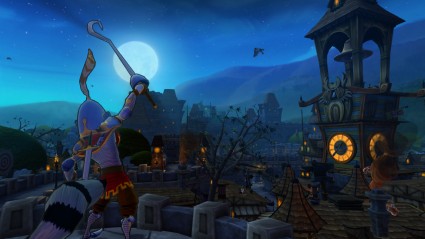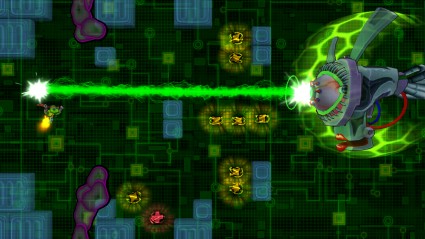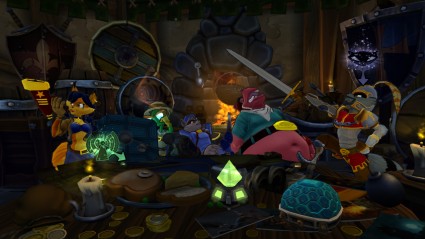Reviews
Sly Cooper: Thieves in Time
April 15, 2013, Author: Andy Corrigan
I think I’m right in saying that Sucker Punch’s Sly Cooper series was one of the PS2’s most popular games. I say ‘think’, because I never got around to playing them myself, yet I’ve been told many times and at great length about their apparent quality. It’ll have been a long time coming for fans, then, but seven years later, Sly finally returns under new developer Sanzaru Games.
Sadly, though, there are times in this business where you’ll come into the latest entry of a beloved series and fail to see what everyone else does. You know as soon as you start writing the review that you’re likely going to upset people, and unfortunately, this is one of those times…
Back in time…
Thieves in Time begins with famous thief Sly Cooper now living a relatively crime-free life, apparently faking amnesia to be with be with his law-enforcing missus, all due to events at the end of the prior game. His good friend Bentley, however, has noticed that words are fast disappearing from the Thevius Raccoonus (Sly’s family history) Back to the Future style, as someone is trying to erase the Cooper legacy.
So back in time the team must go, to rescue Sly’s ancestors and restore the historical timeline… and that’s where my interest in this story waned. Will you discover who’s behind it all? Will you even care? Because, honestly, I really struggled to the more the game went on.
For me, Thieves in Time‘s story-telling amounts to a string of random, silly occurrences, rather than attempts at genuine reasons to do the things you’re doing. I started the game with the best intentions, but found myself rolling my eyes as the plot erratically and arbitrarily shot off in every direction other than the one that benefited the story or reinforced my actions. Not that I feel the game should be serious or that random directions of humour don’t work in the right instance, but I definitely felt a lack of direction was detracting from my enjoyment in this particular case. Essentially, I was given no reason to care.
At the risk of upsetting long-time fans as a result of me having no prior experience with Sly Cooper as a series, it didn’t help that these characters only came off as charmless and boring. Sly’s character never really comes to the forefront as you’d expect, Murray is a poor man’s John Goodman, and Bentley, despite being one of the more interesting of the characters, was simply a consistent point of irritation throughout.
There are a lot of pop-culture references to be found in the story, with the likes of Skyrim and even Prince of Persia lampooned throughout, but it’s never subtle or clever. More like “Look, it’s Back to the Future we’re alluding to here! Hey? Hey?!” *Nudge*.

Sly to the rescue!
Faux stealth
Rather than operating under the orthodox 3D platforming structure that I was expecting, Thieves in Time is actually a little more open-ended. For each historical era that Sly visits in the story, you’re given a new, decently sized open-world playground to tool around in. From the hub of the gang’s secret hideout, you’ll take to the ancient streets to perform the story missions, but at any time you can select another character to explore or collect items until your heart’s content.
As you navigate, you’ll find an emphasis on avoiding conflict, utilising sneaky take-downs over straight combat. This is especially true in the internal environments as Sly, where not getting caught is a mission requirement, not an option. Metal Gear or Splinter Cell it’s not, though, as it’s pretty forgiving throughout.
The missions themselves feature a decent range of activities, while each character has a distinct style, frequently changing how you play the game from mission to mission. As titular hero Sly, you’ll spend most of your time up high, running across rooftops in a way that’s not totally unlike an awkward Assassin’s Creed. You’ll have him performing recon on new areas, taking photos of important story structures and enemies, or use him to break into key buildings to steal items relating to your objective.
As Murray the hippo, you’ll be resigned mostly to the ground with brute strength in combat his only real asset, useful for clearing areas of enemies when the story requires. As wheelchair-bound Bentley, who can hover thanks to his chair’s rockets as well as chuck grenades at destructible items, will be called into action when there’s technological knowledge or explosives involved.
Sly will acquire some extra costumes as he travels through the different eras, and these provide new abilities. The Samurai costume collected as part of an early mission in feudal Japan will allow him to walk through guarded areas unnoticed, and as a cowboy era prisoner, Sly can use his ball and chain to break walls and move large objects, among a handful of others. Sly will really come to rely on these powers in their given era to progress through the story; however, you can use them outside their era too by travelling back to previous levels. In some cases they’ll be able to bag you some secret loot or even provide access to previously unreachable areas.
You’ll also get to play as several other characters along the way and use their own unique abilities, with Sly’s ancestors at the forefront of that. Bob the cave-raccoon can climb certain surfaces, for example, and Ninja Rioichi Cooper can leap from perch to perch quickly, while Tennessee ‘Kid’ Cooper is quite trigger-happy with his gun.

There are plenty mini-games and distractions, possibly too many…
Sadly, though, the game’s handling undermines its interesting structure, feeling wholly out-dated and rigid when compared to newer, better games. As Sly, for example, you can’t just run across a connecting rope between two buildings swiftly and effortlessly, instead having to jump and press the Circle button so he spins up into the air and magnetically attaches to the intended surface. This is also true of any perch you want to land on, and it prevents any potential flow with a real clunky, stop-start rhythm.
The camera is also, frankly, a pain in the arse. Much like the games of two entire console generations ago, the camera is unable to pass through the game’s physical scenery. This means that if you stand near a wall or a pole that’s at the wrong distance, you’ll be wrestling with the camera as it uselessly gets stuck on the scenery.
There are also systems in place for the sake of having systems. You can unlock many new moves and combat-specific abilities by collecting coins and spending them via ThiefNet at the hideout. Here the game does its best LEGO impression, as you’ll need to smash everything you possibly can in levels to collect enough coins for the power-ups. The problem is, these acquisitions are so shallow that they have very little impact on the game and in a lot of cases just serve to make the combat less convenient than normal. Plus, taking the time to collect every available coin slows the game’s already inconsistent pace. If you decided to ignore these abilities and rush through the story, you would be missing very little. In fact, I didn’t even bother with them from the halfway point onwards.
As you’ve probably established, though, this is a game that strives to keep things as varied as possible throughout, and it continues that by throwing in all manner of mini-games and gameplay changes as often as it can get away with. There are several hacking games for example, with shoot ’em up and twin-stick shooting sections, and even marble rolling games using the Six-Axis/Vita Gyroscope. Then there’s the shooting galleries, and the odd (and I do mean odd) rhythm mini-game that pops up from time to time in the story.
Unfortunately, while it’s true there is variety in abundance, it becomes very tiresome. It’s like the game can’t concentrate, its focus unquestionably scattered to the point of detriment; as if the essence of ADHD has manifested in the form of a Sly Cooper title. I’m all for games breaking up their usual patterns with diversions, and there are some clever implementations here; I’d just wished they’d been used smarter or more sparingly.
Lastly, the boss fights are atrocious, either obnoxious to fight through or so by-the-numbers that you’ll be bored before they even start. Each boss has their own pattern to work out before you can take them efficiently, but it’s predictable fare and never takes you by pleasant surprise. The only real surprise was the very final boss fight, which is simply the most detestable string of quick time events I’ve ever had to endure.
It’s worth mentioning that both the Vita and PS3 versions are absolutely identical, and that by obtaining the PS3 version you’ll get a free digital copy of the Vita game too. While it’s certainly a bargain, it also means you’ll be able to make good use of the game’s cross-save functionality. This has been the game’s outstanding feature for me as I played on my PS3 at home on nights, uploaded my save to the cloud before bed, downloaded on my Vita and carried on playing during my lunch break the next day. More of this please, developers.
Looking like a blast from the past?
Visually, Thieves in Time is pretty much the same as you’ve seen in previous entries, with an eerily dark, almost toxic palette that contrasts well against the brighter cartoon character design. I have to admit, it looks really good in this sense, as each era’s game world is an absolute joy to take in as you explore, while the design of the characters is one of the few things I actually liked about them.
The good news is that the PS3 and Vita versions are practically identical, with only some mild stutters for distant moving parts on the Vita version, while the cut-scenes are also compressed just enough that the drop in quality is noticeable with movement. Neither has a bearing on how the game plays, though, so it will have little effect on your potential enjoyment should you decide to play this out and about.
Ancient themes
The OST here is easily one of my favourite aspects of the game and it elicits so many different vibes as you play through. Each era has its own sound as you would expect, such as the Feudal Japan missions capturing its Eastern vibe wonderfully, but each still somehow manages blend into a sax-driven noir flavour. It results in this really interesting mix of styles, that for some reason reminds me heavily of comical old heist or spy movies from Hollywood’s infancy.
Sadly, the voice-acting was just another aspect that left me feeling cold towards this group of characters. As far as I can tell, though, it’s the same vocal team from previous games, so fans shouldn’t find that too much of an issue. The core trio were a huge part of the annoyance for me, though; especially Bentley, who had me reaching for the volume most often.

The hideout acts as your mission hub..
Daylight robbery?
Sadly, despite its try-hard attempts at diversity, Sly Cooper: Thieves in Time only ever struck me as a safe but ultimately dated and bland platformer. There is admittedly the odd flash of brilliance and some lovely examples of level design on display, but the core platforming remains humdrum, and its quick-fire, changeable approach to gameplay only ever serves to become distracting and disruptive. To top it off, trying to find any kind of attachment to such an ordinary band of characters was next to impossible, and thusly left me going through the motions come the end.
Still, I’m certain that if you’ve got that affinity with these characters already, you’ll probably just about find what you’re looking for. For everyone else, though, prepare to be underwhelmed; I have an inkling you just had to be there when the series began.
Platforms: PS Vita, PS3 | Tagged Adventure, bentley, Classic, cross-play, murray, Platformer, platforming, PS3, sly cooper, Stealth, thieves in time, Vita



